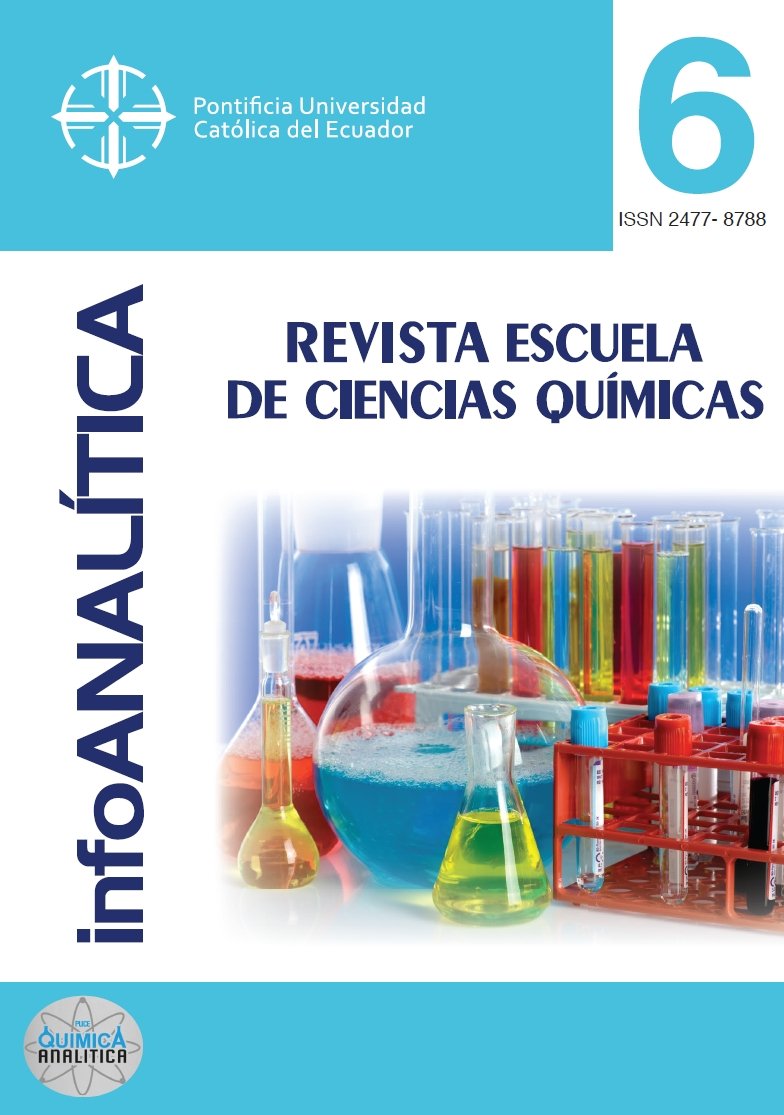Análisis mineralógico y multielemental de la ceniza volcánica, producto de la erupción del Cotopaxi en 2015, por difracción de rayos X (XRD) y espectrometría de masas con plasma acoplado inductivamente (ICP-MS) y sus posibles aplicaciones e impactos
Main Article Content
Abstract
This study had as main goal the mineralogical and multielemental analysis of the volcanic ash product of the eruption of the Cotopaxi volcano in August of 2015; in order to determine possible applications and impacts. The X-ray diffraction (XRD) technique and inductively coupled plasma mass spectrometry (ICP-MS) technique were used for the sample analysis. ICP-MS analysis showed important concentrations of aluminum, sulfur, iron, calcium, magnesium, titanium, alkali metals and alkaline-earth elements according of an andesitic composition. Through the analysis by XRD was determined that the major minerals present in the crystalline phase are plagioclases, orthoclases and silicon oxides (cristobalin); and iron oxide (magnetite, hematite and maghemite), gypsum, dolomite and ma- yenite were found among the minorities compounds. The bibliographic study of the different applications of the elements and minerals found in the ash allows recommending the use of this material as an aggregate in materials and cons- truction due to its mineralogical composition, and avoiding its use as a fertilizer without a previous pH soil determination as it could be potentially toxic.
Downloads
Article Details
- The authors agree to respect the academic information of other authors, and to assign the copyrights to the journal infoANALÍTICA, so that the article can be edited, published and distributed.
- The content of the scientific articles and the publications that appear in the journal is the exclusive responsibility of their authors. The distribution of the articles published in the infoANALÍTICA Journal is done under a Creative Commons Reconocimiento-CompartirIgual 4.0 Internacional License.
References
Casadevall, T. (1991). Volcanic ash and aviation safety: Proceedings of the First International Symposium on volcanic ash and Aviation safety. Seattle, USA.: U.S Geological Survey Bulletin 2047.
Emsley, J. (2011), Natures Building Blocks, First edition, Oxford, UK: Oxford University Press.
Gazey, C. (2016), Effects of soil acidity, Recuperado de https://www.agric.wa.gov.au/soil acidity/effects-soil-acidity?page=0%2C2 (20 de diciembre de 2016)
Guevara, A. (2015). Estudio de las propiedades de las cenizas del volcán Tungurahua, Ecuador, para identificar los factores que determinan su impacto en suelos y cultivos. Universidad Católica de Lovaina, Lovaina, Bélgica.
Instituto Geofísico EPN. (2016). Actualización de la actividad eruptiva--volcán Cotopaxi n°16 y 17. Quito: Instituto Geofísico EPN.
Papale, P. (2014). Volcanic Hazards, Risks and Disasters. Rome, Italy: Elsevier.
Stewart, C. (2013). Protocol for analysis of volcanic ash samples for assessment of hazards from leachable elements. New Zealand: Massey University.
Stewart, D. y Johnston, B. (2006). Contamination of water supplies by volcanic ash fall: A literature review and simple impact modelling Honorary Auckland. New Zealand: School of Geography and Environmental Sciences, University of Auckland.
Taylor, H. y Lichte, F. (1980). Chemical composition of Mount St. Helens volcanic ash. Denver, USA: Geophysical Research Letters 7(11)
Thomas, R. (2013). Practical Guide to ICP-MS: A Tutorial for Beginners. Third Edition. Florida, USA: CRC Press.
Tsukasa, O. y Mitsuhiro, N. (2002). Minerals in volcanic Ash: Non –magmatic minerals. Japan: Department of mineralogy, Tohoku University
U. S. Geological Survey Open-File Report 01-04 (2016), A Laboratory Manual for X-Ray Powder Diffraction: X-Ray Diffraction Primer, USA: Geological survey.

